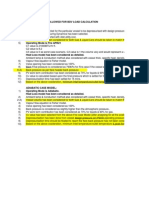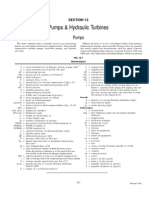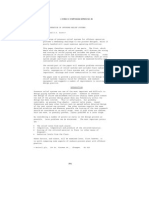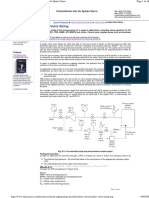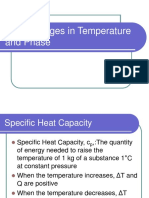521 Ti
521 Ti
Uploaded by
sa.somaCopyright:
Available Formats
521 Ti
521 Ti
Uploaded by
sa.somaOriginal Description:
Original Title
Copyright
Available Formats
Share this document
Did you find this document useful?
Is this content inappropriate?
Copyright:
Available Formats
521 Ti
521 Ti
Uploaded by
sa.somaCopyright:
Available Formats
Sta
nda
Edition Section Inquiry # Question Reply
521 4th - March
1997
General 521-I-01/04 Are there any API guidelines on minimum volumes or materials that would allow
exclusions to relief cases?
No, API 521 does not have any minimum volume requirements as to when to
exclude an overpressure scenario.
521 4th - March
1997
3.1 521-I-09/03 Do relief valves sized in accordance with Table 2 need to be sized for full flow? Table 2 provides a general listing of possible overpressure scenarios and
the basis for determining relief loads. Ultimately, the user needs to define
which overpressure scenario from Table 2 is applicable to specific
equipment, as well as the flow rate for sizing the relief device.
521 4th - March
1997
3.15.1.1 521-I-04/04 Section 3.15.1.1 indicates that portions higher than 25 ft are normally excluded
from effect of fire on the wetted surface of a vessel. On the other hand, in 3.15.1.2,
on the effect of fire on the unwetted surface of a vessel, height limitation is not
mentioned. However, with the same concept as the wetted surface area, I
understand that if a vessel containing vapor is elevated higher than 25 ft above the
source of flame, the effect of fire on the unwetted surface of the vessel is not
necessarily considered. Could you please advise whether my understanding is
correct or not?
Neither the wetted or the unwetted surfaces of equipment higher than 25 ft
(7.6 m) above the surface of the pool fire is normally included when
determining relief load. An exception would be spheres (see Table 4 in the
4th Edition of API RP 521) where, at a minimum, the entire bottom
hemisphere is considered.
521 4th - March
1997
3.15.1.2 521-I-02/02 Should the heat load from the fire be considered when designing a vapor
depressuring system for a dense phase fluid.
The heat input from the fire is generally ignored when designing vapor
depressuring systems for vessels containing gases or dense phase fluids
(i.e., fluids above the thermodynamic critical pressure).
The user may choose to consider the additional contribution of fire heat load
during depressuring by, for example, the use of Equation 8.
521 4th - March
1997
3.15.3.1 521-I-03/04 Background: I am trying to estimate the relieving load from a vessel exposed to
external fire. This particular vessel is liquid filled and the relieving conditions are
in the supercritical region (that is, the pressure relieve valve has a set pressure
above the fluid's critical pressure).
Question 1: Section 3.15.3.1 states that the rate of vapor discharge depends only
on the rate at which the fluid will expand as a result of the heat input. Could you
please clarify the meaning of this statement?
Question 2: Is it still valid to use a latent heat of vaporization of 50 BTU/hr for
purposes of estimating the vapor load?
Reply 1: When pressure relieving conditions are above the critical point, the
rate of vapor discharge depends only on the rate at which the fluid will
expand as a result of the heat input because a phase change does not
occur.
Reply 2: The appropriate application of various assumptions and
methodologies regarding transient behavior of the system, and selection of
device sizing calculations is left to the users judgment.
521 4th - March
1997
3.19 521-I-02/04 Background: My company is working on the construction of a gas plant. There is
an existing finger-type slug catcher in the inlet section of this plant that receives a
three-phase gas stream from a 30-inch pipeline. This slug catcher has been
designed based on ASME B31.8 but its design pressure is different with the
incoming pipeline. I have the following question regarding of depressurization
system for this part of the plant.
Question: Is there any requirement to depressurize this system in case of fire
detection? If yes, please let me know if the criteria are based on API 521, Section
3.19, or are there other criteria for this case?
API 521 does not provide depressurization guidance for specific types of
equipment or vessels. It is up to the user to define what equipment is
depressured.
API Standard 521 - Guide for Pressure-Relieving and Depressuring Systems
Last update: April 8, 2008
Sta
nda
Edition Section Inquiry # Question Reply
API Standard 521 - Guide for Pressure-Relieving and Depressuring Systems
Last update: April 8, 2008
521 4th - March
1997
3.19.1 521-I-02/00
521-I-01/01
Background: The wording in Section 3.19.1 appears to make a differentiation
between a fire depressuring scenario and a process upset depressuring scenario.
This wording is repeated in the second paragraph with respect to depressuring
thick-wall vessels to 50%. In the fifth paragraph, however, it appears that when a
fire is controlling, API recommends the depressuring of all vessels (including thick
wall vessels) to 100 lbf/in.
2
gauge (690 kPa) of 50% of the vessel design pressure,
whichever is lower, in 15 minutes.
Question: Does emergency depressuring only apply to systems greater than 250
lbf/in.
2
(1724 kPa) with a vessel wall thickness greater than 1 in. (25 mm), or can it
be used to depressure any system?
Equipment operating below 250 lbf/in.
2
(1724 kPa) may not necessarily need
emergency depressuring since the consequences of equipment failure due
to fire exposure would be less than that for larger high-pressure equipment.
The statement where fire is controlling is intended to separate those
applications where there are no reactive hazards. If there is a reactive
hazard that can cause loss of containment due to over-temperature, then
emergency depressuring valves may be appropriate for equipment designed
for any range of pressures or services.
For equipment below 250 lbf/in.
2
(1724 kPa) in light hydrocarbon service,
emergency depressuring may be provided. One of the original intents was
to provide emergency depressuring LPG vessels to prevent BLEVE during
fire exposure. Generally, systems in LPG service will have a design
pressure of 250 lbf/in.
2
(1724 kPa) or less. Consequently, the plate
thickness is often less than one inch. As stated in 3.19.1, a greater
depressuring rate may be required for vessels with wall thicknesses less
than one inch. This implies that depressuring
to 100 psig is not a requirement for the higher pressure
applications.
521 4th - March
1997
3.19.1 521-I-01/01 Background: The wording in Section 3.19.1 appears to make a differentiation
between a fire depressuring scenario and a process upset depressuring scenario.
This wording is repeated in the second paragraph with respect to depressuring
thick-wall vessels to 50%. In the fifth paragraph, however, it appears that when a
fire is controlling, API recommends the depressuring of all vessels (including thick
wall vessels) to 100 lbf/in.2 gauge (690 kPa) of 50% of the vessel design pressure,
whichever is lower, in 15 minutes.
Question: Does emergency depressuring only apply to systems greater than 250
lbf/in.2 (1724 kPa) with a vessel wall thickness greater than 1 in. (25 mm), or can it
be used to depressure any system?
Reply: Equipment operating below 250 lbf/in.
2
(1724 kPa) may not
necessarily need emergency depressuring since the consequences of
equipment failure due to fire exposure would be less than that for larger high-
pressure equipment.
The statement where fire is controlling is intended to separate those
applications where there are no reactive hazards. If there is a reactive
hazard that can cause loss of containment due to over-temperature, then
emergency depressuring valves may be appropriate for equipment designed
for any range of pressures or services.
For equipment below 250 lbf/in.
2
(1724 kPa) in light hydrocarbon service,
emergency depressuring may be provided. One of the original intents was
to provide emergency depressuring LPG vessels to prevent BLEVE during
fire exposure. Generally, systems in LPG service will have a design
pressure of 250 lbf/in.
2
(1724 kPa) or less. Consequently, the plate
thickness is often less than one inch. As stated in 3.19.1, a greater
depressuring rate may be required for vessels with wall thicknesses less
than one inch. This implies that depressuring
to 100 psig is not a requirement for the higher pressure
applications.
521 4th - March
1997
5.2.3 521-I-05/00 Background: Section 5.2.3 states: The maximum load from an open depressing
valve normally corresponds to the flow capacity of the valve at the maximum
pressure of the protected equipment; this may be the maximum accumulated
pressure of the equipment.
Question: Is the maximum load calculation based on the maximum operating
pressure or on the design pressure?
The flow rate through the depressuring valve should be based on the
expected pressure upstream of the depressuring valve. Typically, this would
be the maximum normal operating pressure. A higher pressure (e.g., design
pressure or maximum accumulated pressure) may be used depending upon
the scenario, the rate of pressure rise, and the rate at which the
depressuring valve is opened.
Sta
nda
Edition Section Inquiry # Question Reply
API Standard 521 - Guide for Pressure-Relieving and Depressuring Systems
Last update: April 8, 2008
521 4th - March
1997
5.4.1.3.1 521-I-01/02 Should the pressure relief valves rated capacity or the required capacity be used
when determining the outlet piping backpressure?
The rated capacity of the pressure relief valve (not the actual capacity)
should be used to size the tailpipe and the laterals in the discharge line of
the pressure relief device. Common header systems should use the
cumulative required capacities of all devices that may reasonably be
expected to discharge simultaneously in a single overpressure event (see
5.4.1.3.1)
A lateral is defined as the section of pipe from single source relief device(s)
outlet flange(s) downstream to a header connection where relief devices
from other sources are tied-in. In other words, the relief flow in a lateral will
always be from a single source. In contrast, the relief flow in a header can
be from either a single or multiple sources simultaneously.
521 4th - March
1997
5.4.4.3 521-I-02/01 In Section 5.4.4.3, is the noise level calculation in Equation 58 based on the
turbulent mixing noise associated with the pressure relief valve discharge pipe exit
to atmosphere and/or from the pressure relief valve?
The noise level (sound power level) expressed by Equation 58 is for either
the noise due to flow across the pressure relief valve or the noise generated
by flow across the discharge pipe outlet wherever the final discharge point is
to atmosphere.
521 5th - Nov.
2006
Background: The API 521 5th edition section 5.15.7.4 about fire relief calculations for
liquid air coolers indicates the use of Equations (6) and (7) with applying an exponent
of 1.0 to the wetted area term. Now when applying this rule we discovered a
significant difference in the result depending on the selection of the units, either SI or
USC. The root cause of the difference appears to be in the constants C1 and C1,
which have a different dimension when the exponent applied to the "total wetted
surface" is changed from 0.82 to 1.0. Assuming that the equations (6) and (7) were
originally established in USC units, the constants C1=21 000 and C2=34 500 in USC
units could still be correct when applying an exponent of 1.0 to the wetted area term.
In your inquiry (see attached) you requested clarification of API STD-521, 5th
Edition, January 2007, Section 5.15.7.4 as to what constants should be used
in Equations (6) and (7) when applying to liquid filled air coolers using SI
units instead of USC units. You have noted correctly that the equations
were originally derived in USC units. When applying Equations (6) and (7) in
section 5.15.7.4 with SI units, the correct values of C1 and C2 are 66300
and 108900, respectively. When applying these equations in USC units, the
correct values of C1 and C2 are 21000 and 34500, respectively.
However in SI units these constants would be C1=66 200 (as opposed to 43 200) and
C2=108 800 (as opposed to 70 900) when applying an exponent of 1.0 to the wetted
area term as per section 5.15.7.4. Applying the same constants C1 and C2 would
result in a significant difference in the calculated Total heat absorption depending on
the selected units. QUESTION: Please confirm the values for C1 and C2 for use in the
section 5.15.7.4 calculation with Equations (6) and (7) for both units.
521 5th - Nov.
2006
5.15.7.5 521-I-04/07 Question 1: Is 5.15.7.5 recommending that, in general, air coolers should not be
located near equipment containing flammable liquids?
Question 2: If it is not practical to locate air coolers away from equipment
containing flammable equipment, are there any qualifications that could help us
eliminate the need for providing a deluge system?
Reply 1: Yes, however, 5.15.7.5 does not require the use of a deluge
system for fire exposure to a liquid filled air cooler located above process
equipment. A deluge system is one option to mitigate the potential
consequences. It is up to the user to evaluate the risks involved in a
particular application. The alternatives listed in Section 5.15.7.5 are typical
ways to mitigate the consequences.
Reply 2: See Reply 1.
5.15.7.4 521-I-03/07
Sta
nda
Edition Section Inquiry # Question Reply
API Standard 521 - Guide for Pressure-Relieving and Depressuring Systems
Last update: April 8, 2008
521 5th - Nov.
2006
5.19.3 521-I-01/07 Section 5.19.3 a) states that the tube failure is assumed to occur at the back side
of the tubesheet. The statement appears to only consider a tube break at the
tubesheet, i.e. the most appropriate place for shell-side pressure relief device is
close to the tubesheet. However, this would not be the most appropriate location
for relief if a tube were to break at the opposite end of the exchanger. Is this purely
for the determination of the relief rate?
No, this statement is for determination of the relief capacity only. Section
5.19.5 addresses location of the relief device.
521 5th - Nov.
2006
5.20.1 521-I-01/06 Are the depressuring criteria in 5.20.1 only applicable to pool fires? Yes.
521 5th - Nov.
2006
7.3.1.3 521-I-01/07 Referring to 7.3.1.3, can the Mach number be allowed to reach 1.0 in the disposal
system piping?
The calculation check for Mach number is for the pressure discontinuity that
results from critical flow though a piping section or piping component, and
the effect of this on the overall disposal system pressure drop. API 521, 5th
Edition, does not currently provide specific recommendations for maximum
velocities for tail pipes and flare headers, although many companies have
such standards. This topic will be considered for the next edition of the
standard.
521 4th - March
1997
Appendix B 521-I-03/02 Is it the intent of Appendix B to allow the process designer to use a single relief
device to protect a system of vessels and still comply with ASME pressure vessel
code?
Yes, provided all of the criteria in B.1 are met.
521 4th - March
1997
B.3 521-I-12/03 Background: API 521, Section B.1 states, In some cases, a single pressure relief
device may be desirable to protect several equipment components . . . One of the
four criteria to be satisfied is that no means can exist for blocking any of the
equipment components being protected from the installation of the single pressure
relief device unless closure of these valves is positively controlled as described in
API Recommended Practice 520, Part II, Section 2.3 and Section 4.
Question: Can we provide locked open or car-sealed open valves in the
interconnecting piping between the equipment components protected by a single
relief device? Others are interpreting that B.1 only refers to the block valve in the
inlet of pressure relief device, i.e., between equipment and pressure relief device,
and that no valves should be provided in the interconnecting piping between
vessels even if the valves are of car-sealed open design.
It is up to the user to determine whether to use a single relief device to
protect multiple equipment items (reference ASME Section VIII, Division 1
on when it is allowed). If the user so chooses, then Appendix B of API 521
provides guidance.
521 4th - March
1997
B.3 521-I-13/03 Background: When a single pressure relief valve protects a reaction section, it is
stated in par. B.3c that the set pressure should be 105% of the settling-out
pressure of the section, in case of compressor failure. This 5% pressure differential
is also required with a pilot-operated relief valve.
Question: Is it acceptable, from a safety viewpoint, to set the set pressure of a
pilot-operated relief valve at 100% of the settling-out pressure?
Appendix B offers an example of a single relief valve protecting several
equipment components. Section B.3c. provides guidance on the appropriate
minimum vessel design pressure relative to compressor settle-out pressure.
It does not unconditionally provide guidance on the relief device set point.
Relief device set point requirements are specified elsewhere in ASME
Section VIII, Division I, Paragraph UG-134. RP 521, Section B.3.c.
recommends the design pressure of the HP separator to be selected at least
105% of the settle-out pressure to minimize unnecessary flaring during
compressor trips or shutdowns. The relief valve is usually set at design
pressure but consideration should be given to proper blowdown.
You might also like
- API Standard 521 - Guide For Pressure-Relieving and Depressuring Systems PDF100% (4)API Standard 521 - Guide For Pressure-Relieving and Depressuring Systems PDF9 pages
- PSV Tag No. 10A1 Set Pressure Loop Considered Calculation Reference C-22 and HX-27 API-521, 5TH EDITION, MARCH 2007No ratings yetPSV Tag No. 10A1 Set Pressure Loop Considered Calculation Reference C-22 and HX-27 API-521, 5TH EDITION, MARCH 20077 pages
- Selection of Reboilers For Distillation ColumnsNo ratings yetSelection of Reboilers For Distillation Columns25 pages
- Is 600 MM Sufficient To Keep BDV FunctionalNo ratings yetIs 600 MM Sufficient To Keep BDV Functional4 pages
- 2.heat-Exchangers From Ch6 - Mihir's HandbookNo ratings yet2.heat-Exchangers From Ch6 - Mihir's Handbook12 pages
- PC-01 - Process Column Design Calculations Using CademPVD SoftwareNo ratings yetPC-01 - Process Column Design Calculations Using CademPVD Software127 pages
- Characteristics of Thermosiphon Reboilers: Stephan Arneth, Johann StichlmairNo ratings yetCharacteristics of Thermosiphon Reboilers: Stephan Arneth, Johann Stichlmair7 pages
- Storage Tank Protection Using Aspen Hysys: Petroleum and Coal May 2019100% (1)Storage Tank Protection Using Aspen Hysys: Petroleum and Coal May 201911 pages
- Centrifugal Compressor Construction and Testing50% (2)Centrifugal Compressor Construction and Testing10 pages
- Korf Utility: File Name Names List Sorted Names File DetailsNo ratings yetKorf Utility: File Name Names List Sorted Names File Details15 pages
- PROCESS SAFETY&Mdash 1 - Gas Conditioning Failures Show Need For Design Scrutiny - Oil & Gas JournalNo ratings yetPROCESS SAFETY&Mdash 1 - Gas Conditioning Failures Show Need For Design Scrutiny - Oil & Gas Journal6 pages
- Simulation, System and Analytical: Lainnya Blog Berikut Buat Blog MasukNo ratings yetSimulation, System and Analytical: Lainnya Blog Berikut Buat Blog Masuk8 pages
- Gas Blow-By From A Production Separator To Tank PDF100% (2)Gas Blow-By From A Production Separator To Tank PDF7 pages
- Management of Scale Up of Adsorption in Fixed-Bed Column Systems - Odysseas KopsidasNo ratings yetManagement of Scale Up of Adsorption in Fixed-Bed Column Systems - Odysseas Kopsidas45 pages
- Properly Employ Overhead Condensers For Vacuum ColumnsNo ratings yetProperly Employ Overhead Condensers For Vacuum Columns8 pages
- Webinar FAQ - Shell and Tube Heat ExchangersNo ratings yetWebinar FAQ - Shell and Tube Heat Exchangers8 pages
- Heat Exchangers: The Effectiveness - NTU Method: Sections 11.4 Through 11.7No ratings yetHeat Exchangers: The Effectiveness - NTU Method: Sections 11.4 Through 11.715 pages
- Emergency Venting - Calculating Wetted AreaNo ratings yetEmergency Venting - Calculating Wetted Area1 page
- Components of The Glycol Circulating SystemNo ratings yetComponents of The Glycol Circulating System3 pages
- Study About Using MEA in H2S Scavenging - ME Thesis Work - Read Introduction PartNo ratings yetStudy About Using MEA in H2S Scavenging - ME Thesis Work - Read Introduction Part65 pages
- API Standard 520 - Sizing, Selection, & Installation of Pressure Relieving Devices Part I, Sizing & SelectionNo ratings yetAPI Standard 520 - Sizing, Selection, & Installation of Pressure Relieving Devices Part I, Sizing & Selection5 pages
- The Design and Operation of Offshore Relief - Venting Systems100% (1)The Design and Operation of Offshore Relief - Venting Systems24 pages
- Product Transfer Loading System PDS - FinalNo ratings yetProduct Transfer Loading System PDS - Final4 pages
- Engineering Thermofluid Module For Exit ExamNo ratings yetEngineering Thermofluid Module For Exit Exam305 pages
- Solubility of Nitrogen in Liquid Ammonia at 25° From 25 To 1000 Atmospheres0% (1)Solubility of Nitrogen in Liquid Ammonia at 25° From 25 To 1000 Atmospheres4 pages
- Guiggouesdgukedsgukesdgkuwdagkugesdkugwdzku?47 #'Hwagweakwdawawa ) $ ($ - (ZNo ratings yetGuiggouesdgukedsgukesdgkuwdagkugesdkugwdzku?47 #'Hwagweakwdawawa ) $ ($ - (Z2 pages
- Second Term: Subject: Chemistry Duration: 2 Hrs Class: Sss 1No ratings yetSecond Term: Subject: Chemistry Duration: 2 Hrs Class: Sss 14 pages
- Retrofit Guidelines For Suva 95 (R-508B) : RefrigerantsNo ratings yetRetrofit Guidelines For Suva 95 (R-508B) : Refrigerants4 pages
- 1.gas Tankers Relief Valve Setting Why Different in Sailing and Port100% (1)1.gas Tankers Relief Valve Setting Why Different in Sailing and Port6 pages
- Second Semester PH2161 - ENGINEERING Physics-II Important 2 - Mark Questions Unit Wise - 2013 EditionNo ratings yetSecond Semester PH2161 - ENGINEERING Physics-II Important 2 - Mark Questions Unit Wise - 2013 Edition3 pages
- Performance Improvement of Domestic Refrigerator by Using PCM (Phase Change Material) and Refrigerant As A Blend of R290 and R600aNo ratings yetPerformance Improvement of Domestic Refrigerator by Using PCM (Phase Change Material) and Refrigerant As A Blend of R290 and R600a6 pages
- VDU Technical Description: Chemex Modular, LLCNo ratings yetVDU Technical Description: Chemex Modular, LLC4 pages
- API Standard 521 - Guide For Pressure-Relieving and Depressuring Systems PDFAPI Standard 521 - Guide For Pressure-Relieving and Depressuring Systems PDF
- PSV Tag No. 10A1 Set Pressure Loop Considered Calculation Reference C-22 and HX-27 API-521, 5TH EDITION, MARCH 2007PSV Tag No. 10A1 Set Pressure Loop Considered Calculation Reference C-22 and HX-27 API-521, 5TH EDITION, MARCH 2007
- PC-01 - Process Column Design Calculations Using CademPVD SoftwarePC-01 - Process Column Design Calculations Using CademPVD Software
- Characteristics of Thermosiphon Reboilers: Stephan Arneth, Johann StichlmairCharacteristics of Thermosiphon Reboilers: Stephan Arneth, Johann Stichlmair
- Storage Tank Protection Using Aspen Hysys: Petroleum and Coal May 2019Storage Tank Protection Using Aspen Hysys: Petroleum and Coal May 2019
- Korf Utility: File Name Names List Sorted Names File DetailsKorf Utility: File Name Names List Sorted Names File Details
- PROCESS SAFETY&Mdash 1 - Gas Conditioning Failures Show Need For Design Scrutiny - Oil & Gas JournalPROCESS SAFETY&Mdash 1 - Gas Conditioning Failures Show Need For Design Scrutiny - Oil & Gas Journal
- Simulation, System and Analytical: Lainnya Blog Berikut Buat Blog MasukSimulation, System and Analytical: Lainnya Blog Berikut Buat Blog Masuk
- Gas Blow-By From A Production Separator To Tank PDFGas Blow-By From A Production Separator To Tank PDF
- Management of Scale Up of Adsorption in Fixed-Bed Column Systems - Odysseas KopsidasManagement of Scale Up of Adsorption in Fixed-Bed Column Systems - Odysseas Kopsidas
- Properly Employ Overhead Condensers For Vacuum ColumnsProperly Employ Overhead Condensers For Vacuum Columns
- Heat Exchangers: The Effectiveness - NTU Method: Sections 11.4 Through 11.7Heat Exchangers: The Effectiveness - NTU Method: Sections 11.4 Through 11.7
- Study About Using MEA in H2S Scavenging - ME Thesis Work - Read Introduction PartStudy About Using MEA in H2S Scavenging - ME Thesis Work - Read Introduction Part
- API Standard 520 - Sizing, Selection, & Installation of Pressure Relieving Devices Part I, Sizing & SelectionAPI Standard 520 - Sizing, Selection, & Installation of Pressure Relieving Devices Part I, Sizing & Selection
- The Design and Operation of Offshore Relief - Venting SystemsThe Design and Operation of Offshore Relief - Venting Systems
- Solubility of Nitrogen in Liquid Ammonia at 25° From 25 To 1000 AtmospheresSolubility of Nitrogen in Liquid Ammonia at 25° From 25 To 1000 Atmospheres
- Guiggouesdgukedsgukesdgkuwdagkugesdkugwdzku?47 #'Hwagweakwdawawa ) $ ($ - (ZGuiggouesdgukedsgukesdgkuwdagkugesdkugwdzku?47 #'Hwagweakwdawawa ) $ ($ - (Z
- Second Term: Subject: Chemistry Duration: 2 Hrs Class: Sss 1Second Term: Subject: Chemistry Duration: 2 Hrs Class: Sss 1
- Retrofit Guidelines For Suva 95 (R-508B) : RefrigerantsRetrofit Guidelines For Suva 95 (R-508B) : Refrigerants
- 1.gas Tankers Relief Valve Setting Why Different in Sailing and Port1.gas Tankers Relief Valve Setting Why Different in Sailing and Port
- Second Semester PH2161 - ENGINEERING Physics-II Important 2 - Mark Questions Unit Wise - 2013 EditionSecond Semester PH2161 - ENGINEERING Physics-II Important 2 - Mark Questions Unit Wise - 2013 Edition
- Performance Improvement of Domestic Refrigerator by Using PCM (Phase Change Material) and Refrigerant As A Blend of R290 and R600aPerformance Improvement of Domestic Refrigerator by Using PCM (Phase Change Material) and Refrigerant As A Blend of R290 and R600a







